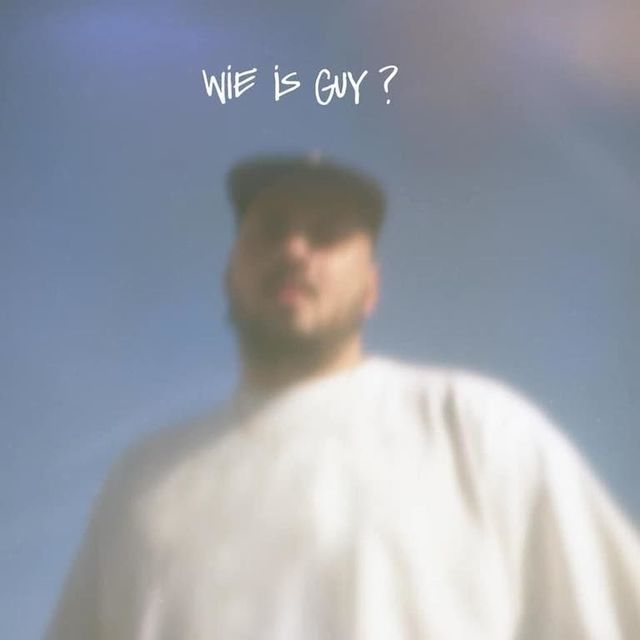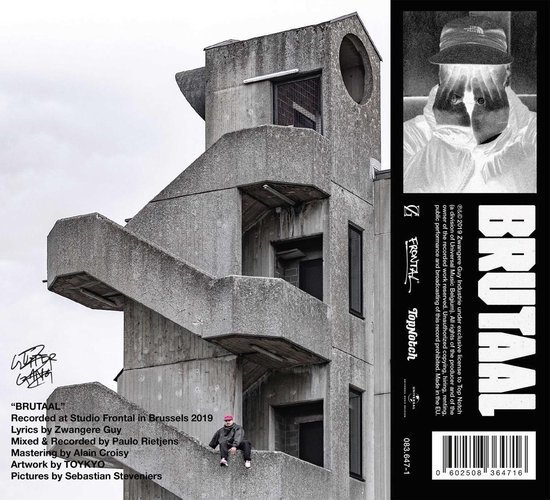Brussels Represent! Meet Hip-Hop Phenomenon Zwangere Guy
Brussels is unruly and elusive, they say. Even writers find it difficult to encapsulate. But there is one person who captures the eclectic face of the Belgian capital in text: with his rhymes, the rapper Zwangere Guy enters into a conversation with his city in order to get to know her better – and to get to know himself better too. ‘More than even my pen, Brussels is my therapist.’
 Ixelles/Elsene, Brussels
Ixelles/Elsene, BrusselsBrussels confronts her visitors and inhabitants with jarring multitudes, which has become a recurring element in the literary image of the Belgian capital. In Pascal Verbekens Brutopia (2019) ‘Brussels is not a city, she is many cities, and therefore elusive, even for those who hail from Brussels. Travel one metro stop too far, wander around one wrong corner, and you land in another world, another time, another language zone. It pinches and it chafes.’ This observation is a timeless one: Charles Baudelaire, who had emigrated to Brussels in the second half of the nineteenth century, was immensely troubled by the chaotic visage of the Belgian capital. The city was as formless as the faces of her inhabitants. According to the Symbolist, who had elevated the notion of metropolitan flânerie to an art form with the poetic precipitation of his Parisian wanderings, Brussels offers nothing more than a ‘visage obscur sans regard’ compared to the city of lights.
 Zwangere Guy
Zwangere Guy© Yaquine Hamzaoui
In contrast to cities like London and Paris, the Belgian capital has never seen the production of a Great Brusselian Novel that might provide her with a recognizable literary character. And yet… Recently, a wordsmith has come to the fore. Not one who plans to conjure up a novel or a book of poetry, but one who ceaselessly chisels away at rhymes that form an urban epic for his beloved Brussels. With tracks that shake the foundations of hit lists, festivals, and radio stations, the Brussels rapper Zwangere Guy (Gorik van Oudheusden, 1988) makes every effort to represent his home city. And he “represents” in both senses of the word. In his rhymes, the rapper sketches not only the Brussels of the 21st century; but in line with the tradition of “representing” – a fixed element of the hip hop genre since it originated in the Bronx in the 1970s – he also aims to proudly represent the place he comes from.
Zwangere Guy has not only managed to look Brussels deeper in the eye than any other pre-eminent literator, he has above all given her, according to writer and childhood friend Frederik Willem Daem, “een bakkes” – a distinct face.
City Custodians in the Here and Now
Gorik van Oudheusden learned to perfect his flows on the Sint-Katelijneplein, Kortweg 54 (cinq quat’, after Place Saint-Cathérine), at the heart of the historic city center. Through the rap battles held there he met Astrofisiks, Jazz, and DJ Vega, with whom he would go on to form the hip hop collective STIKSTOF. Gorik became Omar-G, a pseudonym that later gave way for the name Zwangere Guy: ‘STIKSTOF came up with our own slang, our own jargon. We were tired of hearing American words like “swag”, so we turned it into “pregnant” (zwanger), [like being “heavy” or “laden” with character]. And I was the most pregnant of all.’
With their three albums STIKSTOF (2014), STIKSTOF/02 (2016) and OVERLAST (2018), the collective put Dutch-language rap on Brussels’ map. The gentlemen of STIKSTOF present themselves as ‘city custodians’, charged with protecting Brussels from the judgmental sneers of outsiders.
 From left to right: STIKSTOF (2014), STIKSTOF/02 (2016) and OVERLAST (2018)
From left to right: STIKSTOF (2014), STIKSTOF/02 (2016) and OVERLAST (2018)The track Utopia opens with samples taken from Flemish and Wallonian news reports describing burning cars at the Halle Gate, condemning riots in Anderlecht, and branding the Molenbeek neighborhood as a ghetto. The track itself can be interpreted as a response to the negative representation of the city in the news, which is all too often one-sided. In contrast, it is a sizzling ode to Brussels in which the rappers present themselves as the counterparts to the skittish suburban commuters, who turn their backs on the city by night. They, themselves, are the proud inhabitants of the city, the ‘spray paint vandals’ who ‘march through the streets with bilingual names’. The epicenter of their activities is the Brussels city center, the alpha and omega of their oeuvre.
The track closes with samples from the song Bruxelles by Jacques Brel, as well as Liesbeth List’s cover of the same song: ‘Brussels was a vibrant city back then’. A famous verse from ‘Le temps où Bruxelles bruxellait’ also points to a nostalgia for an inaccessible past when Brussels seamlessly represented its very essence – when Brussels ‘brusseled’, so to speak. The choice of samples speaks worlds: By bookending their own ode to the city on the one hand with negative news reports and on the other hand with a nostalgia for the dancing ladies and gentlemen upon ‘les pavés de la Place Sainte-Catherine’, STIKSTOF puts an end not only to the criticism of the capital, but also to the misplaced nostalgia for a lost home. Their Brussels is a utopia in the here and now; one that the hip-hop collective defends with a fervor.
Brussels: Extra Large and Rare
As a member of STIKSTOF, Zwangere Guy stood out for his technical bravado and hyperkinetic performances. In 2017, he took his first sauntering steps as a solo artist with the mixtape Maternity Leave vol. 3. Rife with jazzy tones, the laidback album highlights the virtuosity of Guy’s flow. The rapper reaffirms his patent upon lyrically-laconic verses. Using culinary metaphors, he makes mincemeat of second-rate rappers and unabashedly compares his hometown to New York – the motherland of hip-hop: ‘The B stands for Brussels, extra large and rare […] / BXL the finest, the rawest thay they’ve seen / We’re building bridges back from Harlem and from Queens.’
Zwangere Guy unabashedly compares his hometown to New York
Though braggadocio is characteristic of the genre, these self-aggrandizing rhymes are grounded in truth. The mixtape was released in 2017, which quickly went down in history as the grand cru year of Belgian hip hop. In the wake of the genre’s rising popularity worldwide, Brussels-based rappers from both language communities joined forces in collaborative shows known as Niveau 4 (a reference to the threat level imposed upon Brussels following the 2016 attacks). Their work debuted on nearly every Belgian radio show and set summer festivals ablaze. With his first solo album to follow, Zwangere Guy would truly shake the foundations of the Belgian music scene.
Insight into the Psyche of Brussels
Zwangere Guy’s debut album is called Wie is Guy? (Who is Guy?, 2019). The album cover features a blurry image of the rapper, who stands against the backdrop of social housing blocks that loom over the Brussels municipality of Ganshoren, where Gorik van Oudheusden grew up. In line with the idea that representing one’s hometown forms the foundation of hip-hop, the question ‘Who is Guy?’ becomes synonymous with ‘Where does Guy come from?’ In nineteen tracks, Zwangere Guy offers multifaceted answers to this question, rooted in his own personal journey through the nineteen municipalities of the Brussels region. The album becomes a conversation between him and his hometown: ‘More than even my pen, Brussels is my therapist. She answers me, we talk, and we both come out stronger.’
 Wie is Guy?, the debut album of Zwangere Guy
Wie is Guy?, the debut album of Zwangere GuyIn tracks like Gorik pt. 1
and A Better Life, the rapper sketches a picture of his home life growing up. Abused by a drug-addicted stepfather with a penchant for violence, the young Gorik shut the door on that life at the age of fifteen, and went to live on his own. He began an apprenticeship as a roofer and a bricklayer, got into drugs, and started dealing them too.
Interviews form a common thread throughout his album. It opens with a jovial skit in which Antwerp’s Miss Angel plays Zwangere Guy’s personal ‘Automatic Answering Machine’. She receives messages from, among others, his friends and random pizza delivery men. In Gorik pt. 1, the voicemails are from Van Oudheusden’s mother. In this track, the messages become increasingly desperate attempts to reestablish contact with her son. The pleas go unanswered: over and over again, the phrase ‘message deleted’ chills the listener to the core. The rapper is namely too preoccupied with another ongoing conversation: the one with the voices in his head.
This polyphony resonates elsewhere on the album too. At times, the multiplicity of voices gives Guy’s characteristically careless delivery an ominous undertone. In the title track Who is Guy?, the rapper compares himself to his own hip-hop heroes to create a flashy mythology around his persona:
The Guy is so rare, the Guy is so cool
Respectable G’s say “voulez-vous”
Your shit is weak and we matter too
TDE, Kendrick, Schoolboy Q
ZG is loco and he admits it too
But the track doesn’t end with this dadaist wordplay. The comical, self-glorifying narrative crumbles to the ground by his own hand at the end of the song:
The motherfucker he’s got no clue
Loiters he lingers, jobless tool
His name is a flop, he thinks its cool
Believed this track? You fucking fool
This pattern recurs time and again: Zwangere Guy answers the question ‘Who is Guy?’ by building up an image of his persona which he then breaks down again. At the same time, he dances around the central question of the album by allowing different voices to do the talking – sometimes even literally, as in Energuy, where various offshoots of the rapper’s personality have a heated conversation inside the stereo.
Polyphony is also found in the album’s multilingual dimensions – the many guest rappers switch between French, English, Portuguese and various dialects of Dutch – as well as in its variegated and colorful production style. The music basks in the atmosphere of the American West Coast with its danceable basslines, blaring organs, and nods to hip-hop subgenres like the 1990s’ gangsta funk, but it also delves more deeply into the electronic party vibes found in trap music.
Just like Guy, the beats have many faces. This is confirmed by Pierre “Peet” Mignon, the rapper behind the French-speaking collective Le 77, who is responsible for some of the funkiest features on the album: ‘If I had to describe Guy’s style in one word, it would be “Brussels”. The city has as many different styles, nationalities, cultures, and languages as he represents. Guy represents his BX.’
The polyphony of Zwangere Guy resonates in the multiplicity of voices on his debut album
With his first solo album, Zwangere Guy had only one goal: to embody Brussels. He takes that quite literally too: he has Bruocsella – the original name of his hometown – and the iconic burning of the Palais de Justice tattooed across his chest. The flag of the Brussels-Capital Region flies at his performances and in his music videos. The album features postcodes of Brussels’ many municipalities, and the rapper spits verses like ‘This is BXL, always represent!’
Rapping in a Concrete Jungle
In interviews, Zwangere Guy proudly asserts that he’s never read any more than four books in his whole life. Still, his work resonates with the images of Brussels found circulating in the capital’s literature. In Arm Brussel (1992), Geert van Istendael denounced the ‘assassination of Brussels’ that took place in the second half of the twentieth century: politicians and property developers joined forces to demolish entire neighborhoods and, with their eyes set on financial gain, erected new buildings upon the land. Van Istendael summarized the outcome of this building frenzy with a reference to the artificial, stepped gables that now stand opposite Central Station: ‘You step out of Central Station, and you see Brussels. […] You see a wall of hideous, unjust facades.’
 BRUTAAL, the second album of Zwangere Guy
BRUTAAL, the second album of Zwangere GuyZwangere Guy repeatedly built up and demolished his self-image in Wie is Guy?, but with its successor BRUTAAL (2019), he seems to build up his own facade. In line with the hip-hop adage of keepin’ it real, this facade must remain honest and authentic at all costs. The album cover is a nod to Canadian rapper Drake’s cover art for Views, which he photographed atop the CN Tower in Toronto. Guy, on the other hand, was photographed atop a brutalist building at the Free University of Brussels. The composition is ironic: he himself only attended school until the age of fifteen, having climbed out of a gutter to get to where he is now.
The image wholly captures where he wants to go with his second album: like the brutalist movement in architecture, which is both loved and reviled for its bare and rough characteristics, the rapper presents himself as uncompromising: ‘I refuse to fall into any grey area. For me, it’s either black or white.’ With his first album, he proved that he wants to harken back to the roots of hip-hop. Now, with his second album, he wants to show the world beyond the shadow of any doubt what he stands for.
With BRUTAAL, Zwangere Guy makes a musical shift from the West Coast to the East Coast, returning to the very roots of hip-hop. He trades in the funky quality of Wie is Guy?
for bare beats that have a New York grittyness to them. In a way, the new album enters into a balancing act with the former. After all, BRUTAAL must dispel the mist left behind by the previous record: ‘I had the feeling that Wie is Guy? left too many questions unanswered. There was too much leisure, too much funk. Now I want to make a dark, cold, wintery record. One that dares to offer up straightforward answers.’
Once again, the rapper uses the motif of the interview as a structuring principle throughout the album. In the song WAAROM – WHY? – he amasses questions from his listeners. The answer? DAAROM – BECAUSE. His answers are as straightforward and brutalist as the industrial beats they support: ‘Because I’m Guy, because I’m zwanger, because I rap / That’s why here, that’s why Brussels, nowhere else, not fucking ever.’
BRUTAAL can be seen as an antidote to the despair experienced by rappers who struggled and fought their way from street life into the music industry. Despite the unparalleled success of Wie is Guy?, the rapper wants to show he is still the same Guy. His triumphant foray into the music scene may mean that he hangs around on the street a lot less than he used to, but he always returns to the basics: ‘Sometimes I have to get away because I wander / Rooted in the city like I’m molded in concrete.’
Reviews of the second album were not as unanimously positive as the first: BRUTAAL was hastily finished – Zwangere Guy dropped the album only nine months after the first – and although he technically takes his flows to a higher level, the album feels less original and haunting than his debut. But this criticism doesn’t seem to bother him. As long as he continues to draw his rhymes from the source, nothing stands in his way. With a metaphor often invoked in reference to the hood of the Belgian capital, Zwangere Guy makes clear that he will never stop rapping from the heart, both feet rooted deeply in the breeding ground of Brussels’ concrete jungle:
Talking is the silver here, and writing is our gold
Like wildlings set free into this rotten concrete world












